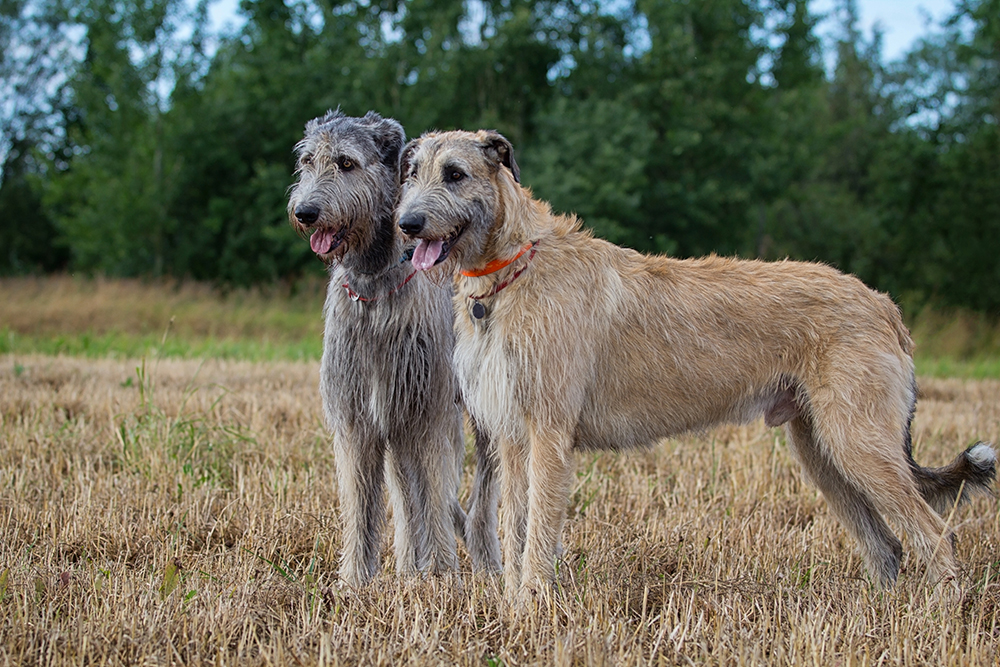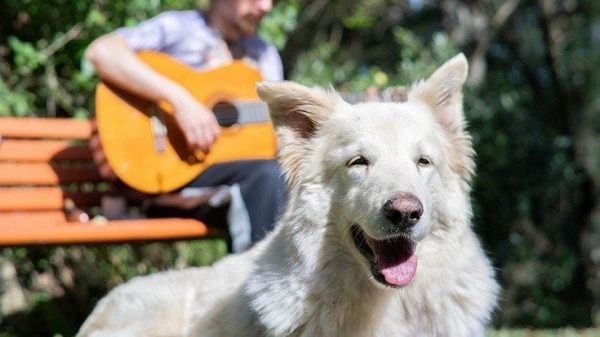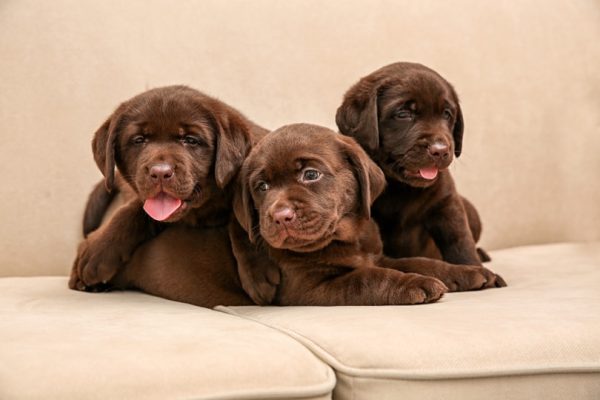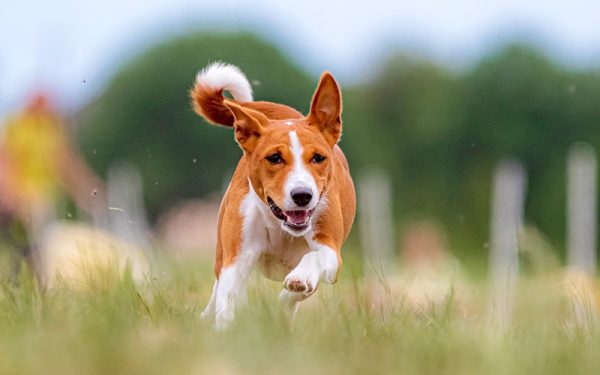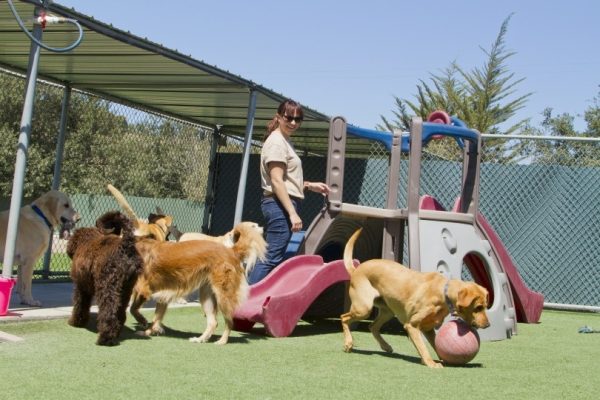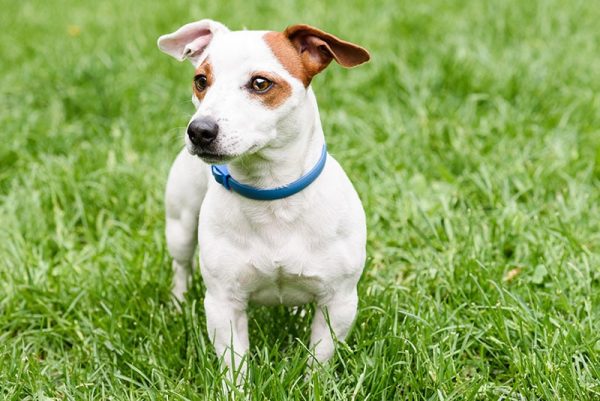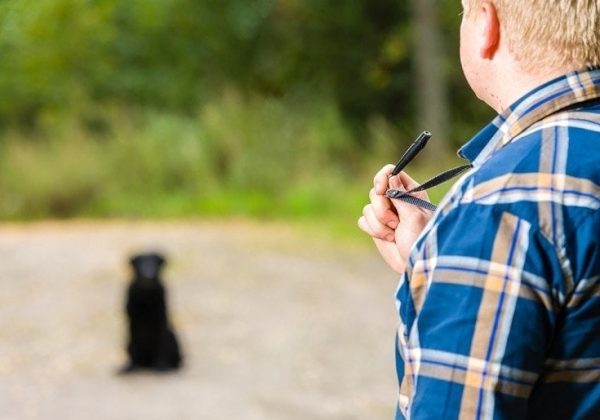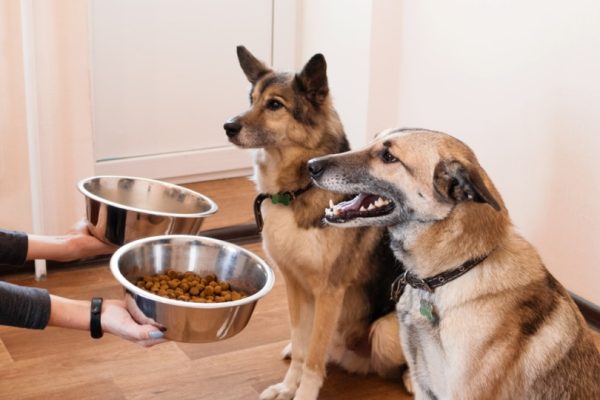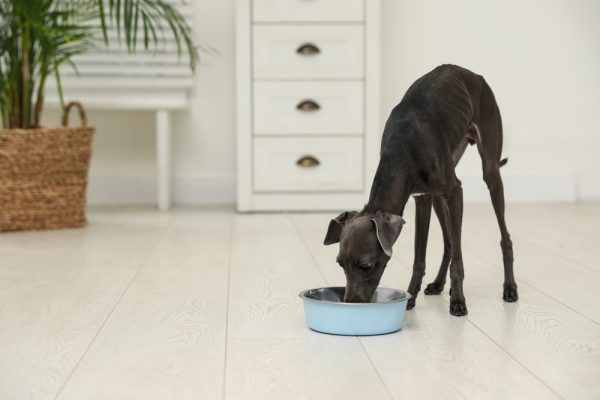While some people prefer small dogs, there are those of us who adore giant dog breeds as well. Big dogs have a reputation for being the most recognizable and hardest-working breed of dogs in the world today, but that also often comes with a strong working instinct and a high prey drive, meaning they can be quite a bit to handle and aren’t for everyone. A lot of the time you will find yourself with an enormous hound that will still try to sit in your lap or share your bed, and many of these giants are as gentle as can be. But be warned that they will eat you out of house and home, cost a fortune in vet fees, and sadly, do not live as long as their smaller counterparts.
While there may be some drawbacks to owning a giant breed dog, there are also lots of positives. Also, there are quite a few factors you’ll want to consider before choosing a giant dog as a family pet. We’ll give you 16 giant dog breeds and a bit of information about them so that you can make an informed decision on whether a giant breed of dog is the right choice for you and your lifestyle.

The 16 Giant Dog Breeds
1. Great Dane
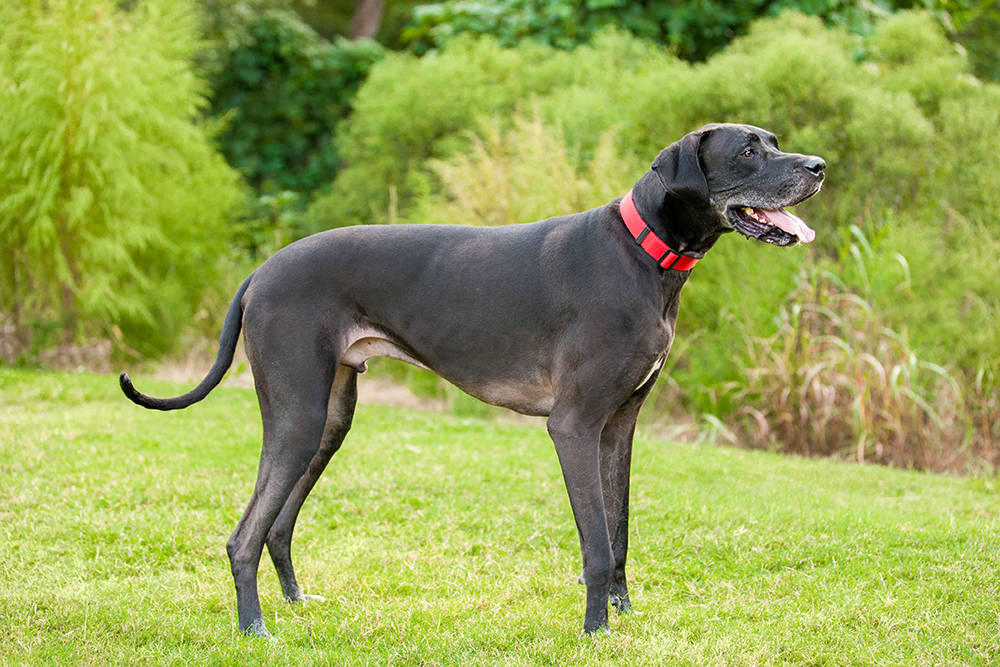
| Group | Working |
| Height | 28 to 32 inches |
| Weight | 110 to 175 pounds |
| Life Expectancy | 6 to 8 years |
This giant dog breed almost resembles a small horse, but don’t let its size fool you. The Great Dane is an easy-going dog that doesn’t necessarily need a yard the size of a paddock, despite their size. These dogs were bred to hunt wild boars and to guard property and their families. They still make great guard dogs but are even-tempered and lovable for the most part.
- Easy-going
- Great guard dogs
- Good for apartment living
- Short lifespan
2. Leonberger

| Group | Working |
| Height | 26 to 32 inches |
| Weight | 90 to 170 pounds |
| Life Expectancy | 7 to 10 years |
The Leonberger is a massive working dog. They’re intelligent, easy to train, and fairly even-tempered. They do make a great watchdog and are known to bond very closely with their family.
This breed makes an excellent family pet and has been used as therapy dogs as well. However, they do drool a lot, so watch your carpeting and furniture when your beloved pet is inside and cuddling with you on the couch
- Even-tempered
- Great watchdog
- Intelligent/easy to train
- Drools a lot
3. Neapolitan Mastiff
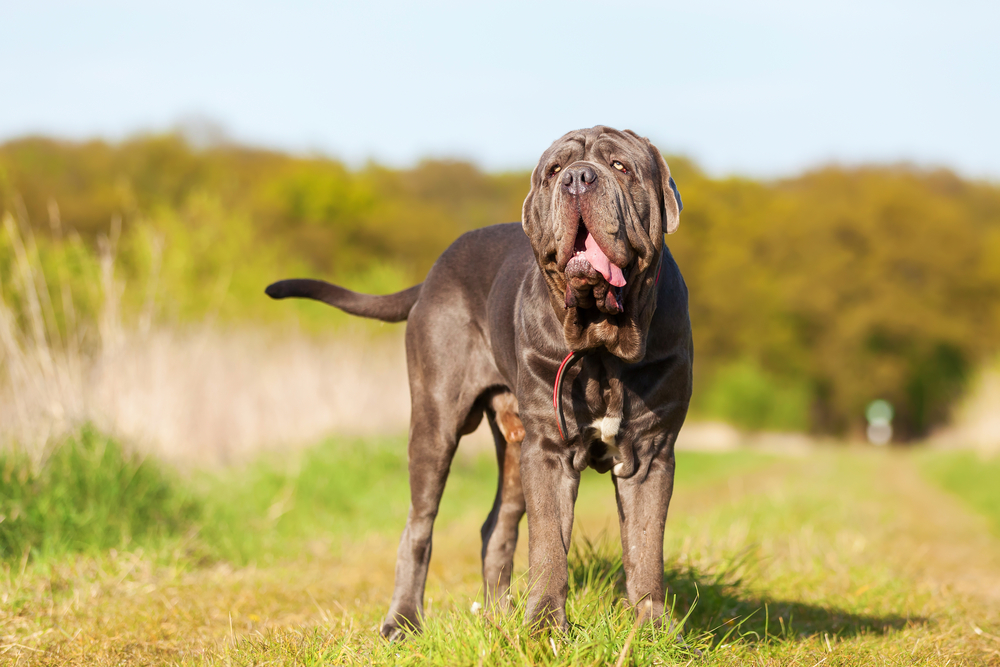
| Group | Working |
| Height | 24 to 31 inches |
| Weight | 110 to 150 pounds |
| Life Expectancy | 7 to 9 years |
The Neapolitan Mastiff is an Italian breed whose origins have been traced back to the time of the Romans. You’ll know the breed by its loose skin, wrinkles, and lumbering gait. These massive dogs make loyal guard dogs, are gentle with their families, and surprisingly don’t need a huge amount of exercise, even with their size.
The dog is a loyal, gentle breed that any family would love to call their own. However, this breed is prone to joint disease, so keep an eye on your pal over the years.
- Gentle with family
- Loyal guard dog
- Requires little exercise
- Prone to joint diseases
4. Irish Wolfhound

| Group | Hound |
| Height | Around 30 inches or more |
| Weight | 105 to 120 pounds |
| Life Expectancy | 6 to 8 years |
Bred as hunting companions and to take into battle, the Irish Wolfhound also guarded the property and homes of their owners. However, in today’s world, this giant dog breed is used mostly as a companion pet. They are friendly, loyal, and gentle with children. Another great advantage of adopting one of these large pets is that they don’t shed very much.
On the downside, they do have quite a short lifespan and need large spaces to roam, so you won’t want to keep this breed hemmed up in a small house with no yard or an apartment.
- Friendly
- Gentle with kids
- Doesn’t shed much
- Short lifespan
- Don’t do well in smaller homes
5. Dogue de Bordeaux
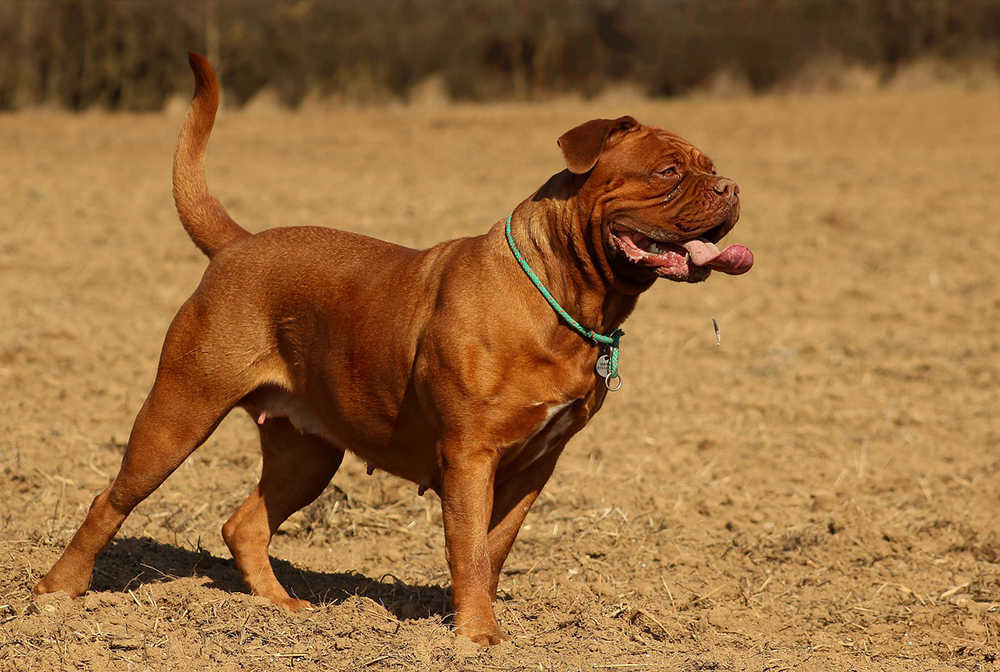
| Group | Working |
| Height | 23 to 27 inches |
| Weight | 100 pounds or more |
| Life Expectancy | 5 to 8 years |
If you’re looking for a super lovable pet, then the Dogue de Bordeaux breed could be the right large pet for you. Loyal and protective, this breed is also quite courageous while still having an even temper. They are slobbery and have massive heads that make them look scary and ferocious when they usually aren’t.
Since this breed’s origins started in France, they are often called French Mastiffs as well. It is important to note that this breed often doesn’t get along well with other pets, especially other dogs.
- Loyal/protective
- Courageous
- Has an even temper
- Doesn’t get along well with other pets
6. Great Pyrenees
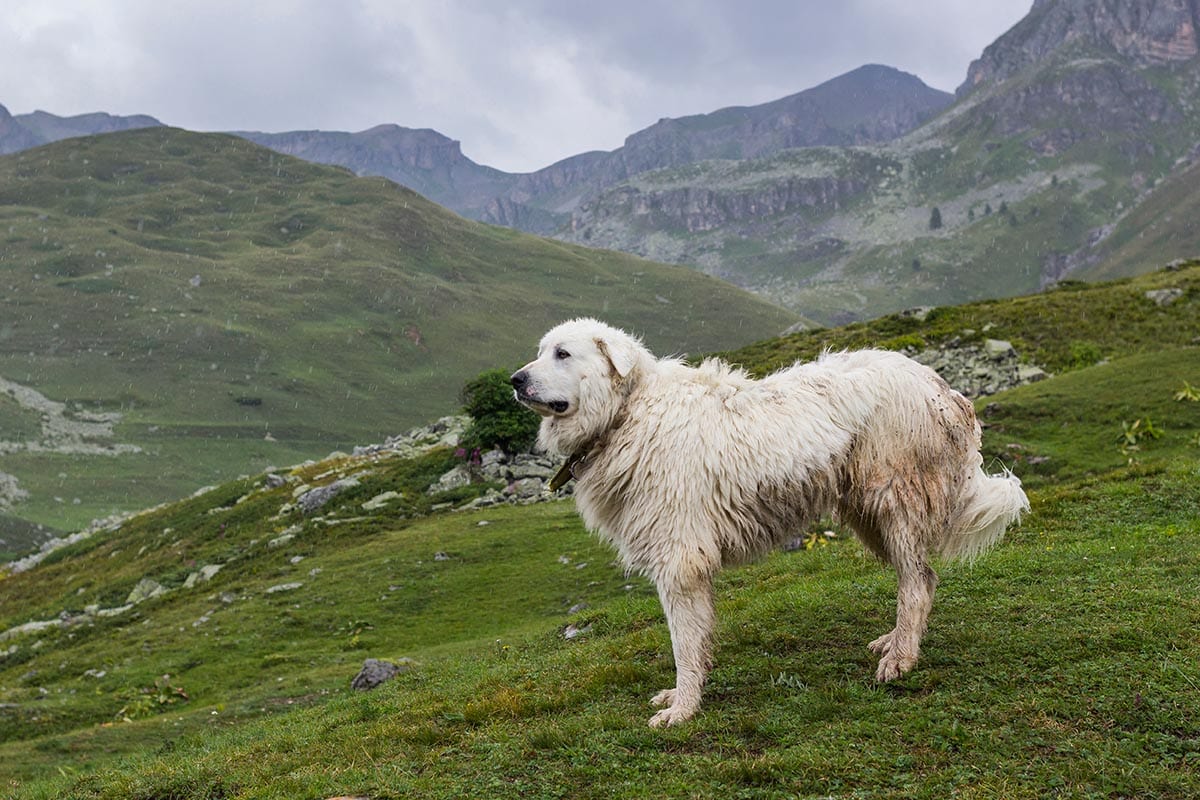
| Group | Working |
| Height | 25 to 32 inches |
| Weight | 85 pounds or more |
| Life Expectancy | 10 to 12 years |
The Great Pyrenees breed is massive, not only in power but in size as well. However, they are calm, affectionate dogs that get along well with children and most other family pets. Bred as a working dog, the Great Pyrenees was used to guard people’s homes and their sheep.
They are a very active breed, so they need plenty of exercise and may have to have obedience training to make them well-behaved. However, they do tend to bark a lot, especially at night, as a warning to their owners.
- Calm and affectionate
- Loyal and protective
- Gets along well with most pets and kids
- Barks a lot, especially at night
- Need a lot of exercise
- May need obedience training
7. Newfoundland

| Group | Working |
| Height | 26 to 28 inches |
| Weight | 100 to 150 pounds |
| Life Expectancy | 9 to 10 years |
The Newfoundland breed has webbed feet and waterproof coats, so they are perfect for a family that spends a lot of time on the water. This breed is full of great workers and makes a loyal, protective family pet. While they are generally a calm breed, they have an instinct to protect, especially the children they love.
It is essential to note that this dog needs a lot of space to be healthy and happy, so don’t put them in an apartment or a small house with no yard and expect them to behave.
- Loyal and hardworking
- Protective of loved ones
- Calm
- Needs a lot of room to be happy
8. Bullmastiff

| Group | Working |
| Height | 24 to 27 inches |
| Weight | 100 to 130 pounds |
| Life Expectancy | 8 to 10 years |
The Bullmastiff breed is a cross between a Mastiff and a Bulldog, and their origins can be traced back to the 1900s. This powerful dog was bred to stop poachers from invading people’s lands. Today, while this dog still makes an excellent watchdog, the breed is quite gentle and loving. They need very little exercise and have short hair, so they’re easy to groom.
However, it’s important to note that this huge dog can be aggressive if notproperly trained and socialized. They also have a relatively short lifespan of only 8 to 10 years.
- Great watchdogs
- Need little exercise
- Short hair is easy to care for
- Can be aggressive
- Short lifespan
9. St. Bernard
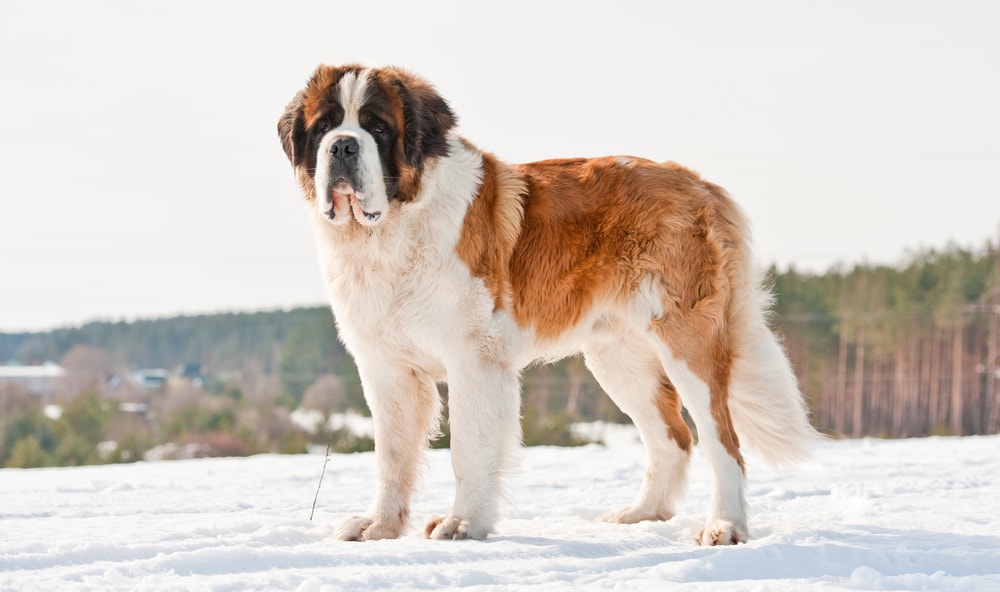
| Group | Working |
| Height | 26 to 30 inches |
| Weight | 120 to 180 pounds |
| Life Expectancy | 8 to 10 years |
St. Bernard’s are a giant breed with a giant heart. They have their origins as search and rescue dogs and are often used as service animals. This breed is extra lovable, gentle, and loyal. They are known for being great family dogs and are often quite gentle with children.
However, they do have a short lifespan of between 8 and 10 years. They are powerful dogs and have a tendency to pull when on the lead, so early training is essential to avoid an escaping dog or dislocated shoulder! And if you’ve seen the film Beethoven, you will know that the St. Bernard is also famous for slobbering!
- Gentle/loyal
- Eager to please
- Lovable
- Short lifespan
- Needs constant attention when on a leash
- Lots of slobber
10. Mastiff

| Group | Working |
| Height | 28 inches or more |
| Weight | 120 to 230 pounds |
| Life Expectancy | 10 to 12 years |
The Mastiff breed is a soft-hearted breed that looks to be all brawn on the outside, but as you know, you can’t judge a book by its cover. These pets are gentle, loyal, and protective. While they are protective of their families, this breed gets more laid back as they age.
Be warned that Mastiffs eat a lot, so have extensive food requirements. They are a regular slobber fest, and their tails can do significant damage once they start wagging.
- Gentle and loyal
- Great family pets
- Laidback as they age
- Extensive food requirements
- Tails cause significant damage
- Excessive slobbering
11. Anatolian Shepherd
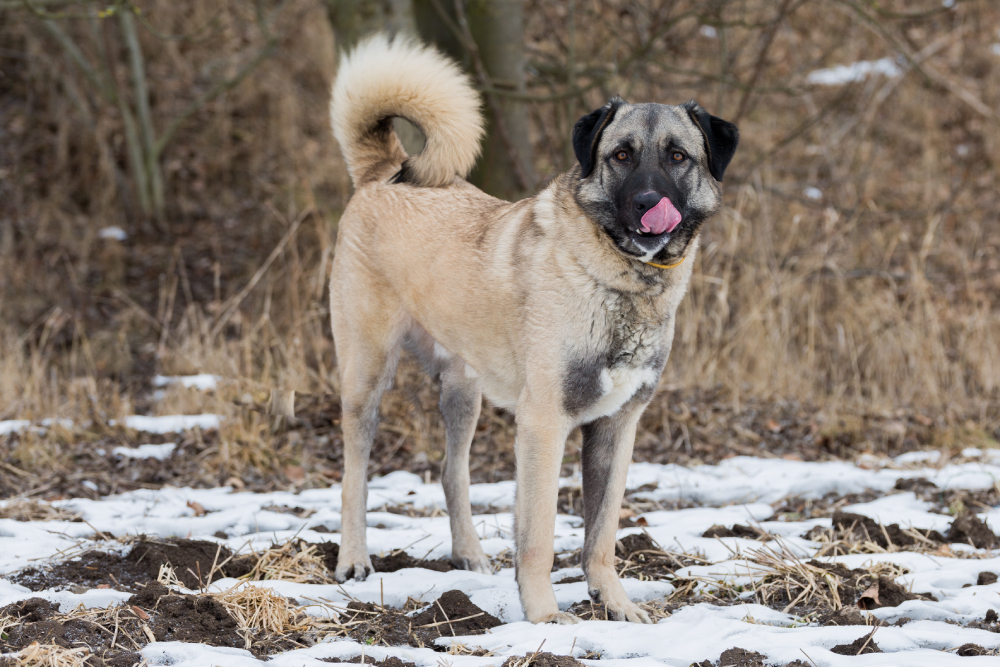
| Group | Working |
| Height | 27 to 29 inches |
| Weight | 110 to 150 pounds |
| Life Expectancy | 11 to 13 years |
The Anatolian Shepherd is a territorial breed, which makes it an excellent guard dog. This breed is confident, energetic, smart, and loyal. These dogs are also excellent working dogs. The breed was developed to protect livestock and would rather intimidate a threat than attack it.
This is not the right breed for an inexperienced dog owner, and they don’t make good family pets. However, they are an excellent choice for protecting a farm or ranch, so if you own one of these, this is a good choice for your needs.
- Energetic
- Make good guard dogs
- Confident
- Not for beginning dog owners
- Not a family pet
12. Bernese Mountain Dog

| Group | Working |
| Height | 23 to 27.5 inches |
| Weight | 70 to 115 pounds |
| Life Expectancy | 7 to 10 years |
The Bernese Mountain Dog features a distinctive tri-colored coat. They love the cold weather, are hard workers, and are extremely loyal. This breed is energetic yet laid back at the same time. They do have a short lifespan of between 7 to 10 years and are heavy shedders, so be careful when you have them inside your home.
They are heavy droolers as well. These are some of the most popular giant dog breeds and are great as companion animals.
- Great family pet
- Loyal
- Energetic yet laid back
- Short lifespan
- Heavy shedder
- Drools a lot
13. Cane Corso

| Group | Working |
| Height | 23.5 to 27.5 inches |
| Weight | 90 to 110 pounds |
| Life Expectancy | 9 to 12 years |
The Cane Corso breed is one that forms close bonds with its family. The breed is strong and loyal and makes an excellent watchdog. However, they are alert and can be intimidating to those who don’t know them. Since these dogs can be wary and protective of their families, it’s extremely important to socialize and train them from an early age.
The breed is easy to groom but do have joint problems due to their large size. The large size, in fact, may make it hard for smaller adults and children to handle the dog, so be careful when out walking this breed.
- Forms close bonds with family
- Makes a good watchdog
- Easy to groom
- Joint problems
- May be hard for children and small adults to handle
14. Black Russian Terrier
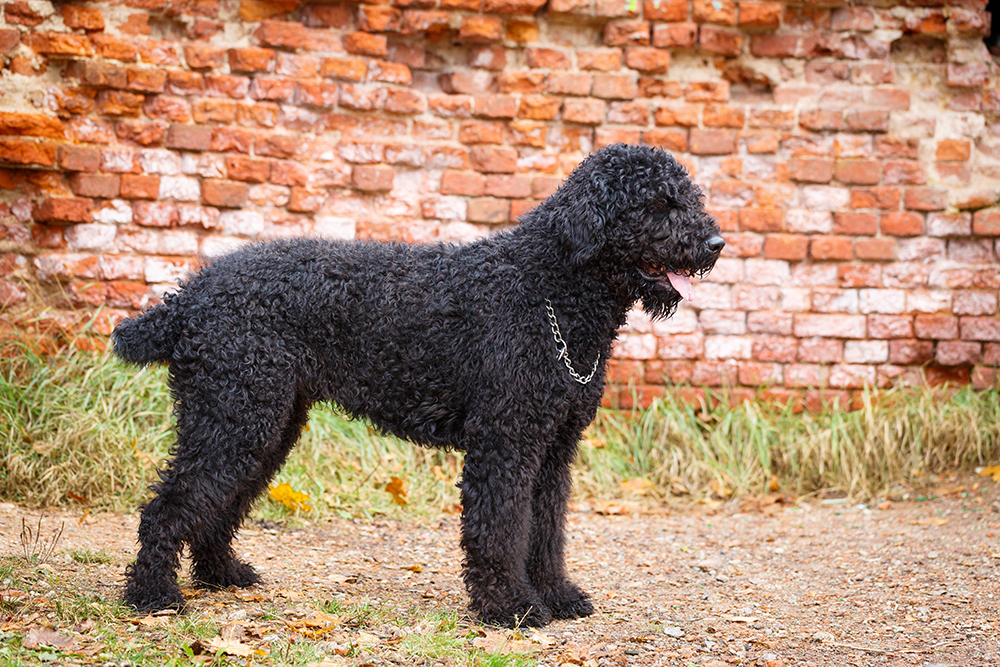
| Group | Working |
| Height | 26 to 30 inches |
| Weight | 80 to 130 pounds |
| Life Expectancy | 10 to 12 years |
The Black Russian Terrier is as intelligent as it is imposing. Extremely protective, this breed is loyal and loving to the family who owns one. The breed is calm and does well with apartment living, provided they are given plenty of time out in the open to stretch those long legs. However, they can be quite aloof with strangers and have a dominant personality.
They do suffer from many of the health problems that affect larger breeds, so keep an eye on your pup as they head into their later years. This is the perfect dog for someone looking for a watchdog and family pet at the same time.
- Loyal and loving
- Calm
- Lives well in apartments
- Dominant personality
- Some large-breed health problems
15. Scottish Deerhound
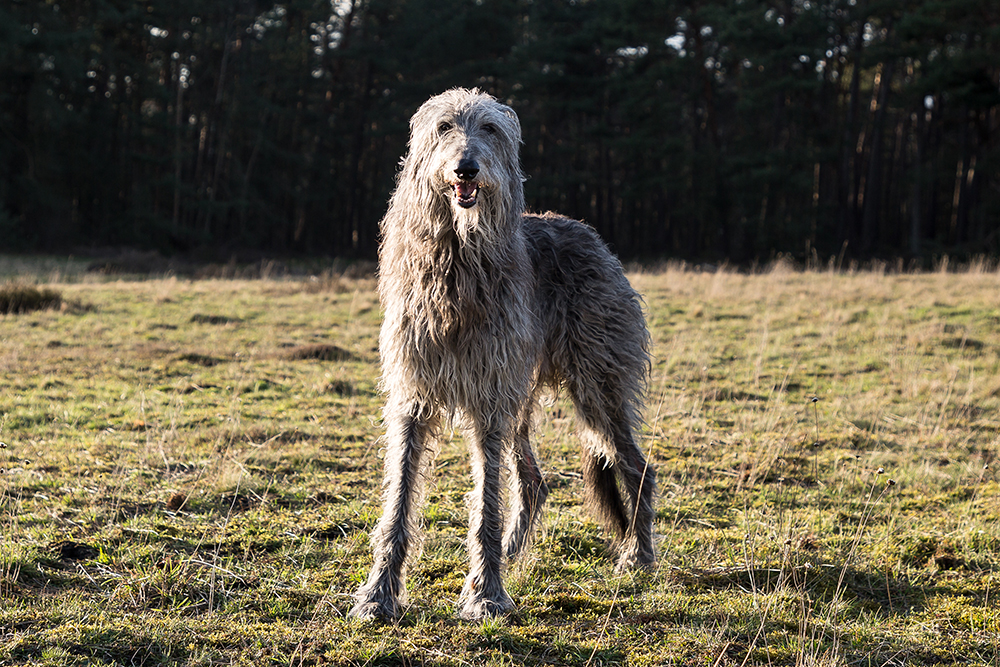
| Group | Hound |
| Height | 28 to 32 inches |
| Weight | 75 to 110 pounds |
| Life Expectancy | 8 to 11 years |
The Scottish Deerhound is the royal dog of Scotland and is one of the tallest breeds of dogs in the world. Bred to hunt, this breed loves to run, so make sure you have plenty of space to accommodate them, as they wouldn’t thrive well in an apartment setting. They also have quite a strong prey drive, so keep an eye on them around smaller pets, as they love a good chase.
The breed is playful, gentle, friendly, and loving to their family. They may have issues walking on a leash, so make sure to train this large breed early on in life.
- Playful and gentle
- Friendly
- Loving
- Doesn’t need to live in an apartment
- Has issues walking on a leash
- Strong prey drive
16. Tibetan Mastiff
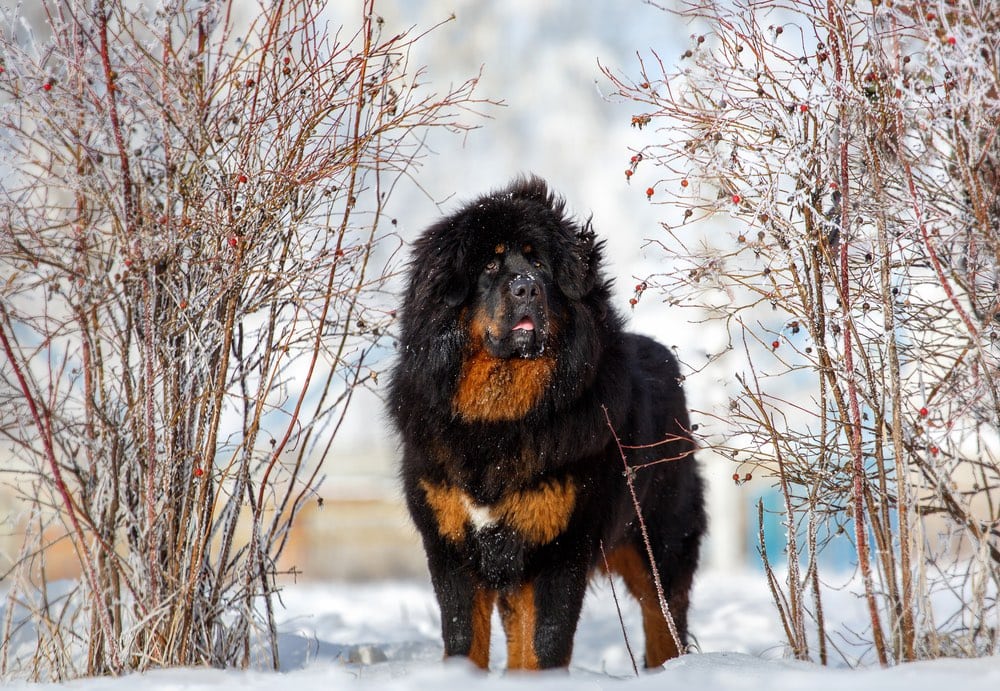
| Group | Working |
| Height | 24 to 26 inches or higher |
| Weight | 70 to 150 pounds |
| Life Expectancy | 10 to 12 years |
The Tibetan Mastiff is an intimidating, independent, strong-willed dog that dates back to ancient times. They’re excellent guard dogs and seasonal shedders, which means they shed very little throughout the year. These dogs are extremely protective and are not recommended for first-time dog owners.
They can be hard to train due to their strong wills, so socialization and training need to begin early in their lives. It’s important to note that this breed may become aggressive to other dogs if not socialized and trained properly as well.
- Great guard dog
- Requires little exercise
- Seasonal shedder
- Hard to train
- May become aggressive with other dogs

Tips for Owning Giant Dog Breeds
Although very few of these dogs are predisposed to aggression, and most are actually very gentle giants, their size alone can make them dangerous if not properly trained and socialized, as unruly or boisterous behavior can lead to injury, particularly for youngsters.
Many of these dogs will already be the size of a Jack Russell Terrier by the time you bring them home as puppies, so it is essential that you start rigorous training from day one. As most of these breeds experience shorter lifespans and joint issues, here are some tips to help them stay happy and healthy:
- Keep them at a lean body weight to reduce joint strain.
- Start them on joint supplements from a young age.
- Avoid overly strenuous activity until their bones and joints have finished growing (usually around 18 to 24 months old).
- Schedule a health check once or twice a year to ensure their joints, heart, and everything else is as healthy as possible.
HOT TIP: While recall, obedience, and proper manners are an essential part of training your giant dog, we recommend thinking twice before teaching them to “give paw.” Some dogs will try to offer a paw in order to get a treat, which is cute when you have a smaller pup, but it can be a nightmare when that paw is huge and coming at you from a very tall dog!


Conclusion
This concludes our list of the 16 types of giant dog breeds you can find today. Many make great family pets, while some aren’t for first-time pet owners or families. Do your research, take your time, and make sure this is truly the pet you want before giving one a forever home.
It’s important to note that owning a giant dog as a pet is a huge responsibility, so make sure you’re ready for the challenge. Your reward will be a loyal, protective friend for many years to come.
See Also:
- Who Are the Biggest Dogs in the World? World Records
- Big Dog Breeds That Don’t Drool: History, Pictures, & Info
Featured Image Credit: DragoNika, Shutterstock

